Tahrir Square
As I was thinking about my next blog I decided to take a break from the museum of Islamic art. But I didn't know what I shall write about which has a sense of history then I thought every tiny part of Egypt has a historical perspective. Then today I was passing by Tahrir square and I thought why not write about it but the problem with this type of place is that it was covered a lot by many people as it had always been a spotlight, especially after the 25th of Jan revolution, but then I thought that everyone had covered Tahrir square as a square only but no one wrote about every building in the square so while I was in the square I decided to write about the history of the square and also write about every building individually, not only covering its history but also discover the design and the idea of choosing the design.
In this blog post, we are trying to explore the history of Tahrir Square as a symbol of liberation; and all its surrounding buildings.
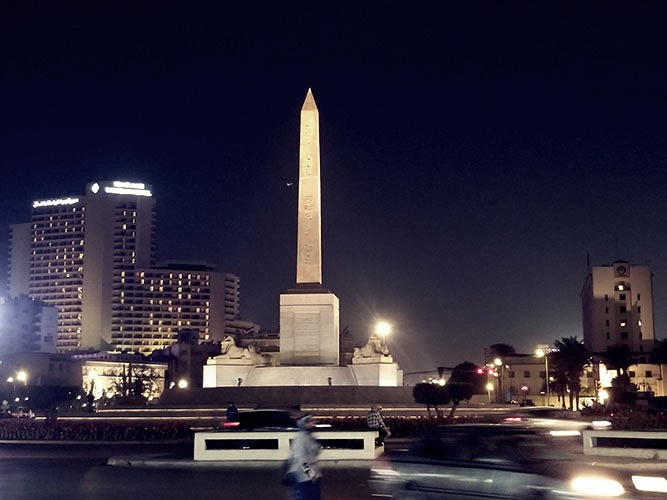
Tahrir Square: How it got its name
Tahrir Square which means Liberation Square was built during the rule of khedive Ismail as most of the building of downtown Cairo is attributed to this period. It was originally named after his name but during the 1919 protests it was named Tahrir Square (Liberation Square) by the protestors, but it was officially named Tahrir square after the 1952 revolution and the change of the regime from a constitutional monarchy to a republic. During all this time there was a statue-less pedestal that was installed by King Faruk in the middle of the square. This statue was removed in 1987 during the construction of the Cairo underground named Cairo Metro. The square which was a focal point of one of the most important Egyptian public arising in the 20th century regained its focus in the 2011 revolution which led to the overthrow of Egyptian president Hosni Mubarak. Since 1987 the square didn’t include any sculpture but it just had a garden in the center, till 2013 the interim government erected a memorial for the activists and protestors who were killed during the revolution but this didn’t last for more than two weeks, and was removed by the protestors. In 2015, an Egyptian flag was erected in the middle of the square.
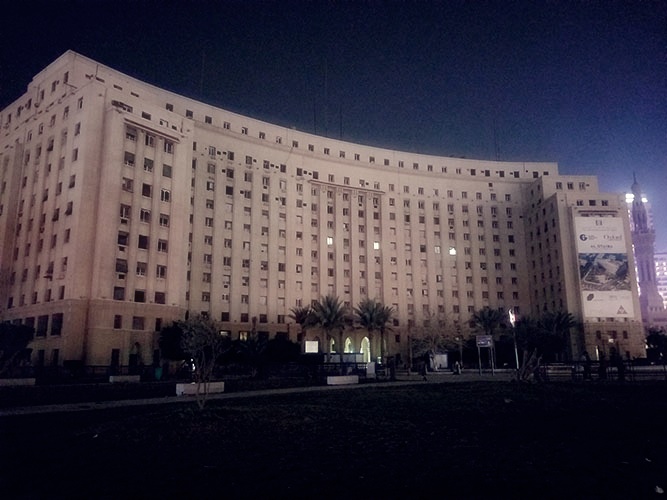
Mogamaa El Tahrir
The first building in el Tahrir square is El Mogamaa which is a word in Arabic that can be translated to “an Assembly”; it was referred to by this name because it was built to collect all government agencies in one place. The building was planned in 1945 and the construction started in 1946 and was finished in 1949. The building was built in a modern style but what is noticeable is the use by the architect of the Islamic style in the main entrance of the building. This combination of the Islamic art and modern is now also used by many interior designers which adds more authenticity and charm to any structure.
The building was designed by Egyptian architect Mohamed Kamal Ismail who also designed the high court in Egypt and planned the expansion of the Great Mosque of Mecca and Al-Masjid an-Nabawi in Saudi Arabia. The place of building used to be a British Barack during the British occupation of Egypt. The building was used in many Egyptian movies as a symbol of the government's stubborn bureaucracy. There were many plans for decades to move all the government agencies in El mogamaa to decrease the traffic in downtown but finally, two years ago all the agencies were moved and it is planned to change the building to become a five-star hotel.
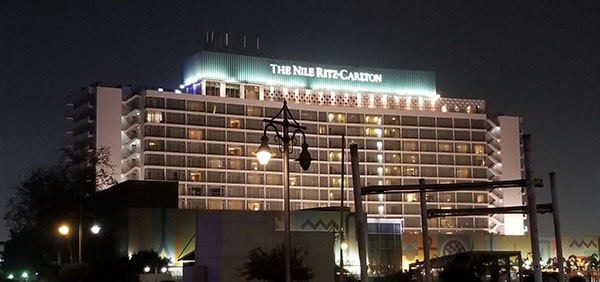
Nile Ritz Carlton Hotel
On the North West side of the square lays the Nile Ritz Carlton hotel. It was built in 1959 and was opened by the Egyptian president Gamal abd el Nasser the Syrian president Hafez el Assad and the Jordanian king Hussein It is owned till this year by the Egyptian Government but there are some rumors that it was sold during the privatization process of government equities in the year 2022. The hotel was managed by Hilton at the beginning but recently the management was transferred to Ritz Carlton. Many celebrities resided in the hotel; American President Ford, Frank Sinatra, and Elizabeth Taylor. The thirteen stories building had a modern style and include 327 rooms and 52 sweets.

Umar Makram Statue
There is also the Statue of Umar Makram which is the only statue that lies in the Square from our modern history. The statue was built in 2003 by Dr. Farouk Ibrahim 1937-2010 who is a prominent Egyptian sculptor that implemented many sculpture works during his lifetime for many prominent figures in Egypt including Abbas el Akkad a famous writer in the first half of the 20th century, Hafez Ibrahim who is a well-known Egyptian poet and Talaat Harb who is a well-known Egyptian entrepreneur and the founder of Bank Misr who is still to this moment the most important bank in Egypt.
Umar Makram 1755-1822 is a famous Egyptian leader who fought against the French occupation of Egypt in the early years of the 19th century, but before that he fought against the brutality and injustice of the Mamluk rulers Ibrahim and Murad Bek. He was the leader of El Ashraf group which is a group that still exists till this moment of all the ancestors of the Islamic prophet Mohamed. In 1801 he succeeded in the exile of the French occupation and He also resisted the British Campaign on Egypt in 1807 which is known as the “Fraser expedition”. He was one of the most important powers that helped Muhammed Ali to rule Egypt but after a few years, Muhammed Ali couldn’t stand any opposition Ali decided to exile Umar Makram as a major symbol in the Egyptian resistance so he can solitary rule Egypt.
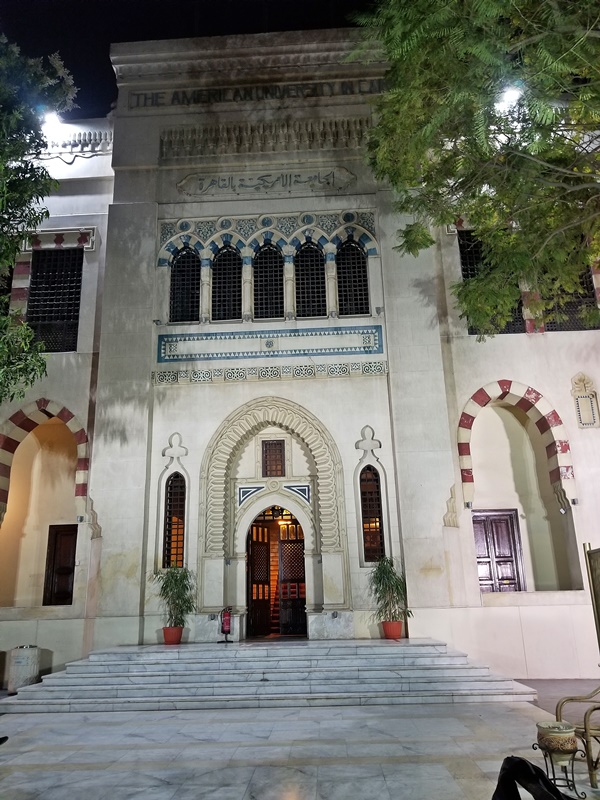
American University in Cairo Old Campus
On the southeast side of the square lies a really beautiful building in the Islamic style surrounded by a vast garden, it is the building known as the American University in Cairo it is an old building that was originally built in 1870 during the rule of Khedive Ismail as a palace for the education minister at that time Ahmed Khairy Pasha who seemed to be very close to Khedive Ismail at that time, and after the death of Khairy Pasha, it became a factory of cigarettes for a very brief time. Then in 1908, it became the first resident of the Egyptian University in Cairo. In 1919 it was bought by Charles Watson who had become the founder of the American University in Cairo which is one of the most prestigious Universities at the current moment. Recently, the university was moved to New Cairo and the building is currently named Tahrir Culture Center which conducts many cultural events including screening of movies, Musical Concerts, exhibitions, and forums.By coincidence while I was in the square taking photos I attended this concert in Tahrir Cultural center. The concert for a band called Bahgaga which can be translated to some kind of euphoria, and they really provide some kind of euphoric mood. They play original Arabic songs so I thought it would be nice to include it in my blog, you can turn on the sound and enjoy the Egyptian rythme in the following video

Umar Makram Mosque or el Sheikh el Abit as it is used to be called
On the opposite direction of the American University building lays Umar Makram mosque; which is well known in Egypt as the place where funerals are conducted for major Egyptian politicians and celebrities. The mosque was originally built in 1320 during the rule of el Nasser Ebn Kalwan and was attributed to an Islamic scholar el sheikh Mohamed el Abit who was buried inside. After the 1952 revolution it was re-constructed and was named after the Egyptian resistance figure Umar Makram.
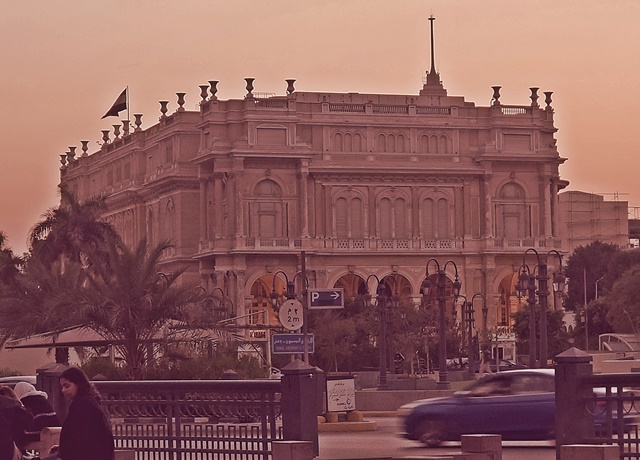
Ministry Of Foreign Affairs Building
On the same side of the Umar Makram mosque lays a really beautiful square building that was built in the western classic style and was designed by an Italian architect Antonio Lasciac designed many buildings in many Eastern capitals and Egypt, he took part in the rebuilding of Alexandria after it was bombed by the British in 1882 and he was also the designer of the Tahra Palace in Cairo 1907, he died in Cairo on October 1926. The building is currently known as the ministry of foreign affairs building, but originally it was built in 1906 as a residence for one of Muhamed Ali’s ancestors el amir Ahmed Refaat who is the oldest son of Ibrahim Pasha the son of Muhammed Ali. Ahmed Refaat as the oldest son was planned to be the ruler of Egypt instead of Khedive Ismail but he died in a train accident. After the death of el amir Ahmed Refaat the palace was inherited by princess Neamatallah who married in the palace but due to unfortunate incidents she lost her child Amina after that, the government bought the palace to become the ministry of foreign affairs.
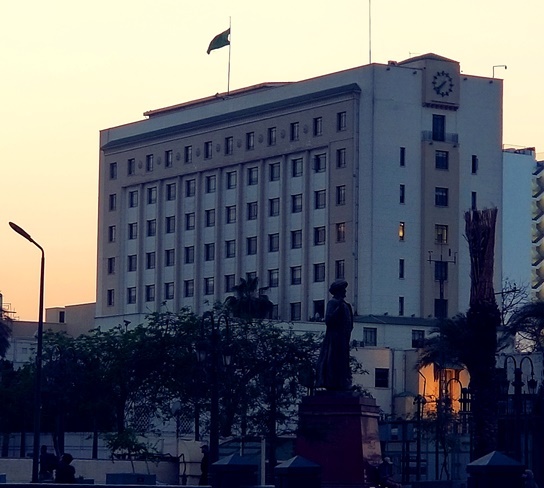
The League of Arab State Building
On the exact opposite side of the ministry of the foreign affairs building lays the League of Arab State building The building was built in 1956 and finished in 1958 and is considered a permanent resident of the league. The first one who called for some kind of coalition between the Arab Nations was the British Prime Minister Eden in 1941; then it was adopted by the Egyptian prime minister of this time Mostafa el Nahas and the Syrian Prime Minister Gamil Merdem. The first meeting of the Arab League was conducted there in the presence of most Arab Leaders at that time. The Arab State league was founded in 1944 long before this building and its headquarter was in the boustan palace in Cairo, the first major decision was the joint intervention against the Israeli occupation of Palestine. The league started with six countries Syria, Lebanon, Jordan, Iraq, Egypt, and Yemen and now it has 22 members.
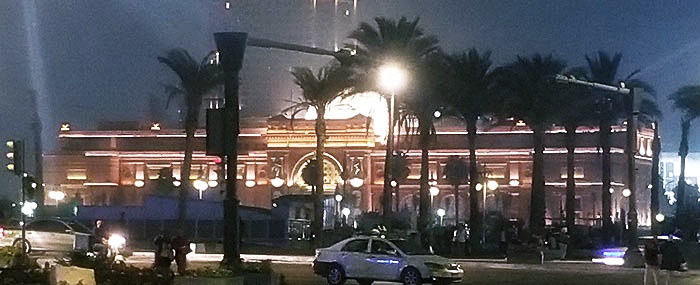
The Famous Egyptian Museum
On the north side of Tahrir Square lays the famous Egyptian museum which is currently named the old Egyptian museum as the new one is about to be opened by the pyramids. The work started in the new one more than ten years now and it is planned to be one of the biggest and most prestigious museums in the world. The old museum was built in 1897 and was opened on 15th November 1902 in the time of Khedive Abbas Helmy II It houses more than 160,000 artifacts dating from the prehistoric through the Roman periods. The building was designed and built by Marcel Dourgnon French architect through an international competition. One of the most important pieces in the collection of the museum is Pharaoh Tutankhamun's treasure, including its iconic gold burial mask, widely considered one of the best-known works of art in the world and a prominent symbol of ancient Egypt.

Ramesses II Obelisk
Finally, in 2020, the government erected the Ramesses II Obelisk which was moved from Tanis and four ram-headed sphinx statues moved from Karnak temple in Luxor. Tanis was the capital of Egypt during the 19th dynasty of Egypt rule. Tanis lies in the northeast side of Egypt. The idea of placing an obelisk in a major square was first conducted by the French when they placed Ramesses II Obelisk in the Concord square in Paris a place which was a major destination during the French revolution and was the place where the guillotine was used as an execution weapon against the revolution enemies as they were perceived at that time. The Concorde Obelisk was transported from Luxor to Paris in 1833 and was erected in 1836 by King Louis Phillipe
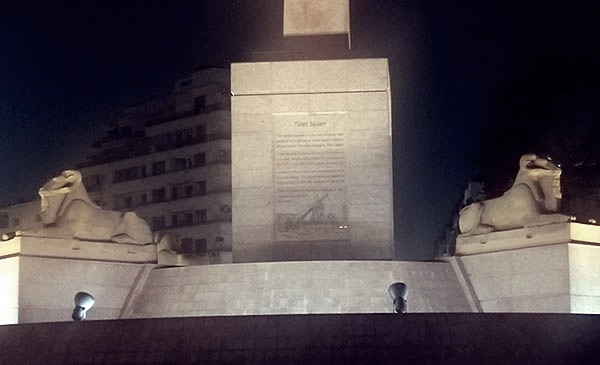
Karnak Temple Sphinx
The sphinx surrounding the obelisk in the square was transported from Luxor to Tahrir square, it was taken from The King’s Festivities Road in the famous Karnak temple. This road with the sphinx is more than 3500 years old and was used by the ancient Egyptians for celebrations related to their gods and Pharaohs. This road was buried for many centuries till it was discovered in 1949 by Egyptian archaeologist Zakaria Ghoneim. The road is 2.7 miles long and includes 1300 sphinx statues with sheep head and lion bodies.








